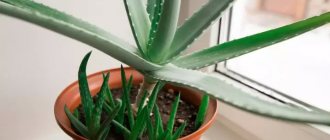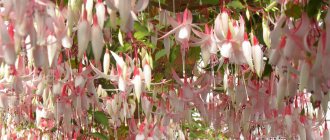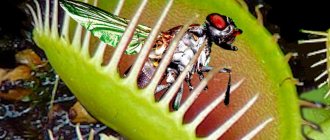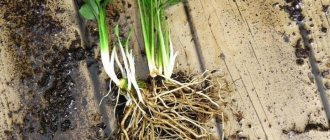What to do if the plant breaks off?
Often people have to deal with the fact that the stem of a flower breaks. Sometimes this happens when moving or as a result of careless tilting of the plant. The top of the aloe comes off, leaving its roots in the bowl. In this case, the relevant question will be how to properly plant aloe in a pot. You need to take the broken part of the plant and place it in a cool place. Wait a few hours.
Prepare suitable soil and a container for the agave. Take a flower and plant it in moist soil. In this case, the stem should be deepened by about 2 cm. It is recommended to water as soon as the soil becomes dry.
It must be remembered that aloe should not be watered frequently. This plant easily survives drought. In summer, the flower actively develops. It is recommended to water it once a week. In winter, aloe sleeps, so it is worth moistening the soil 2 times every 30 days.
As aloe grows, it needs regular feeding. It is recommended to fertilize the plant in summer and autumn. Do this about once a month. As fertilizers, you can use compounds intended for cacti and succulents. Liquid mixtures based on minerals are also often used for feeding.
It is recommended to install the plant in well-lit places. However, remember that aloe does not like direct sunlight. There should be no dry air in the room. In order for the plant to actively develop, it is recommended to regularly spray its leaves. The room in which the flower is located should be ventilated from time to time. However, it should be borne in mind that aloe does not like drafts.
Winter time is the period of plant hibernation. In cold weather, you should not disturb it with fertilizing, transplanting and frequent watering. If you follow these rules, you can provide your flower with complete and high-quality care.
Aloe is a member of the lily family, a group of succulents. Its main distinguishing feature is its long, fleshy leaves covered with soft spines. Aloe is grown by indoor flower lovers not only as an ornamental plant, but also as a medicinal plant.
How to grow aloe from a shoot without roots
Sometimes the question arises of how to plant aloe if the shoot is without a root. It is quite possible to grow a plant in this case if you act correctly.
Schisandra chinensis - how to plant correctly
This situation may arise in the following cases:
- the lateral branch had to be disconnected;
- the bush requires rejuvenation;
- The roots of the plant rotted, but the top survived.
Important! Since aloe is a succulent, it is not recommended to root the shoot in water, as it can rot, so it is better to plant it directly in the soil.
Are there any chances of success?
Before planting a cutting without roots, it is necessary to refresh the cut and leave it to dry for 2-3 days in a shaded place. During this time, a kind of film is formed that protects against infection from penetrating the plant tissue and prevents excessive evaporation of moisture.
Rooting of the shoot occurs within 3-4 weeks
In the meantime, it is necessary to prepare special soil for the aloe shoot. In this case, you need to mix turf soil and river sand in a ratio of 1:2. Heat it in the oven for 15 minutes. at a temperature of 100 °C to disinfect.
To plant the shoot, you can use a plastic glass, make drainage holes in it, lay expanded clay on the bottom in a layer of 2 cm, and fill the remaining 2/3 of the volume with the prepared substrate and moisten it. After this, plant the shoot, deepening it into the soil until the first pair of leaves. Then compact the soil at the base and sprinkle the surface with small pebbles. This will strengthen the seedling and prevent it from falling.
For complete rooting, it is necessary to move the container with the cuttings to a bright place with a temperature of 23-25 ° C, and the plant should not be exposed to direct sunlight. Periodically it is necessary to moisten the soil, observing the rule - it is better to underwater than to overwater.
If the entire procedure was carried out correctly, the shoot will take root without any problems. This can be determined by the new leaves that begin to appear at the top.
For your information! A month after rooting, the shoot must be transplanted into suitable soil and pot.
How to plant correctly?
The optimal time of year for planting aloe is early spring, when all the plant’s forces are concentrated on developing the root system. The frequency of transplants depends on the age of the agave:
- young plants are replanted annually;
- flowers 2-5 years old are transplanted into a new pot every 2 years;
- old aloe is replanted once every 3 years.
In order for the seedling to take root in a new place, you must follow the planting rules:
- Prepare a nutritious turf substrate.
- Spray the roots and above-ground parts of the seedling with Fitosporin.
- On the third day after transplanting, place the pot in a well-lit window.
- Do not water the plant for 7 days after transplantation, so as not to cause root rot.
- After 3-5 days, pour water into the pot tray.
- After two weeks, feed the agave with a weak solution of humus.
- Add wood ash infusion to water for irrigation.
Choosing soil and pot
The substrate for planting should be slightly acidic (pH in the range of 6.0-8.0), loose and nutritious. Optimal soil mixture recipe:
- 3 parts of turf;
- 1 part vermicompost;
- 1 part peat;
- 1 part sand.
To save time, you can buy a ready-made mixture “For succulents and cacti” in the store.
It is also important to pay attention to the choice of pot. It should be wide enough (up to 30 cm) for unhindered root development, as well as stable and made of ceramic
Important! You need to lay 3-4 cm of drainage at the bottom of the pot, and pour 2 cm of sand on top of the main soil.
Preparing the appendage: how to take the baby?
The process of taking a shoot is carried out as follows:
- The soil in the pot is thoroughly moistened to soften it and make it more pliable.
- The plant is carefully removed from the pot and the maturity of the appendages is assessed.
- If they are sufficiently developed, they are separated from the rhizome using a garden trowel.
The most important thing when cutting off the “baby” is not to damage the root system of the mother plant.
Reference! The optimal temperature for keeping a seedling before transplanting is 16-18 ºС.
How to transplant?
Algorithm for appendage transplantation:
- Wash the roots to remove soil residues.
- Treat them with a weak solution of potassium permanganate or hydrogen peroxide. This is necessary to prevent infectious diseases and root rot.
- Place the shoot on the drainage in the center of the pot - so that the base of the stem is 3 cm below the edge of the pot.
- Holding the stem, sprinkle the seedling with soil. The soil should be sifted first.
- Compact the soil and sprinkle with a thin layer of sand.
- Water generously at the root.
During the first 3 days, the plant must be protected from direct sunlight (to avoid burns).
Attention! In most cases, aloe infection occurs at the time of transplantation. Therefore, all operations must be performed with sterile gloves, the soil must first be steamed at a temperature of 60 ºС, and containers and equipment must be disinfected with chlorine solution
Planting dates and correct soil selection
The best time to plant aloe is spring. From mid-March to the end of May, the flower begins to grow, develops quickly and takes root in a new place. If necessary, the plant can be planted in autumn or even winter, but in this case there is a high probability of its death.
Before transplanting an aloe sprout, it is necessary to choose the right soil that will facilitate rapid rooting of the sprout. It grows best in balanced cactus soil. The main thing is that the substrate contains a lot of useful substances and iron.
Basic soil requirements:
- neutral or slightly acidic soil is the most acceptable;
- Coal or sand can be used as additives.
- it should be well loose, with excellent breathability;
It is not recommended to add peat, otherwise the substrate will become too acidic. Before using soil to grow aloe, it is advisable to expose it to high temperatures.
Growing aloe
Agave and aloe vera have a lot in common in care. Both plants prefer plenty of sunlight and regular, but not frequent watering, need feeding during the period of active growth, and they also reproduce equally.
Aloe propagation
Tree aloe and aloe vera can be propagated both by seeds and vegetatively: by cuttings, top shoots and root shoots.
After ripening, the seeds are sown in small containers in late winter - early spring. The temperature in the room should not be lower than 21°C. Use special soil for succulents or prepare the soil yourself from leaf soil, turf soil and sand (in a ratio of 1:0.5:1). Place drainage at the bottom of the container.
After germination, the seedlings are transplanted into small pots one at a time in soil consisting of leaf and turf soil (1 part each), as well as sand (0.5 part). You can add a little charcoal and brick chips to the soil mixture. Water the sprouts sparingly, avoiding overwatering. After a year, the plants are replanted using the transshipment method.
Aloe cuttings can be propagated throughout the year, but it is best to do this in the spring and summer. Unlike other plants, succulent cuttings cannot be placed in water for germination, nor can leaves if you want to propagate it with them.
Instead, place the cuttings or leaves in a dark place to dry for a few days. Then powder the cut with activated carbon powder or any root former, for example, Kornevin and plant it in damp sand to a depth of 1 cm. A week later, when the roots appear, transplant the cutting into a separate pot.
Aloe is propagated by upper shoots and root shoots according to the same principle as by cuttings. Only they are deepened into the sand by 2-4 cm more and tied with pegs. After rooting, their care is usual.
Aloe care
In nature, aloe plants survive in conditions in which other plants wither and die. But this does not mean that they do not need care on the windowsill.
Although aloe is a light-loving plant, you should not expose it to direct sunlight. Just keep it on the sunny side.
The succulent does not tolerate excessive watering, which can cause it to develop root rot.
An excess or lack of moisture can be judged by the appearance of aloe leaves. If brown spots appear on them, it means the plant is overwatered. The yellow tint of the leaves and their curling indicate insufficient watering.
From April to October, you need to water the succulent once a week, and the rest of the time - once a month. No more than 100 ml of settled water should be poured under the root of the plant; for large specimens - no more than 1 glass. Make sure that the liquid does not get on the leaves.
Aloe also needs constant ventilation, because... fresh air is important to him. In summer, it is better to put it on the balcony or take it out into the garden if you live in your own house.
The succulent is also unpretentious in terms of temperature, but it should not fall below 10-15°C.
Due to the fact that aloe grows actively from April to September, it should be fed monthly with special fertilizers for succulents. But you should refuse to use universal fertilizers.
Aloe is replanted in the spring: young plants annually, adults - once every 2-3 years.
Can it be placed in open ground?
You can transplant an aloe leaf into open ground, but only for the summer. If the spring in the region is warm and there are no frosts, then planting work should be carried out at the end of May.
It is important that the daytime temperature is 25-30 degrees, and the night temperature does not fall below 12 degrees.
Transplanting aloe into open ground is carried out as follows:
The first step is to choose a landing site. It should be carefully lit, but only direct sunlight is unacceptable.- You also need to make sure that the aloe does not get wet during rain, otherwise it will rot.
- Once the location has been selected, you can dig a hole, the size of which will be slightly larger than the size and depth of the pot where the plant is located.
- Send sawdust or coal to the bottom, and sprinkle a layer of expanded clay on top. This layered “pie” is completed by a ready-made earthen mixture.
- Place the plant in the prepared hole and sprinkle with nutritious soil mixture.
Growing aloe at home
Thanks to the unpretentiousness of agave, it can be easily grown at home in any quantity. It reproduces with the help of:
- children (young bushes that grow next to an adult);
- parts of the stem;
- pieces of leaf;
- seeds
Reproduction using shoots (children) is perhaps the easiest and fastest way. As an adult aloe bush develops, it produces a large number of young shoots that grow near it and represent a fully formed plant, with a root system and leaves. A significant number of children in a pot with a mother flower dulls its growth.
Therefore, they simply need to be removed periodically. Therefore, the use of this method of reproduction is also indicated for the favorable growth of adult agave. Once harvested, the babies are immediately ready to be planted in an individual pot. It should be noted that before removing the shoot, the soil must be watered abundantly so as not to damage the young roots during replanting. A drainage layer and soil are placed in the pot. The shoot should be buried in the soil up to the lower leaves. The soil is lightly pressed down and watered. In the future, caring for a young agave is the same as for an adult. The plant takes root quite quickly and well in its new location.
It is also easy to grow agave without roots, using the upper part of the stem
In this case, it is important to properly prepare the cuttings. For these purposes, use the upper part of the stem with at least two leaves. After the cutting is cut from the main bush, it needs to be given time to rest.
Within a week, the cut areas should dry out a little. During this time, the cutting can be stored in a paper towel at room temperature or on the bottom shelf of the refrigerator. Afterwards, the cuttings need to be planted in the ground, adhering to the planting principles outlined when children examined aloe. Since cuttings are a way of growing agave without roots, to improve the survival rate of part of the stem, it is covered with a glass jar. Under conditions of constant temperature and humidity, the cuttings quickly form a root system and take root. Just remember that this method of growing requires daily care: ventilation, watering. When young leaves appear on the surface of the soil, the jar can be completely removed; the agave has taken root well and started growing.
Regarding whether cut stems can take root in a glass of water, the opinions of flower growers are diametrically opposed. Some strongly recommend that before planting the cutting, keep it in water until it takes root. Others insist that the stems rot when left in water for a long time and it is best to plant them in the ground immediately.
Therefore, the right to choose how to root the cutting remains with the grower; in any case, if one of the chosen methods turns out to be less effective, then the rapid reproduction of the agave will allow the reproduction to be repeated without damage to the population.
The next way to propagate aloe is using a leaf. Of course, this will take a little more time, but this is an ideal opportunity to get an adult plant when there are no shoots or cuttings.
First of all, a leaf 3-5 centimeters long is cut off. It is dried for a week, that is, placed on a paper napkin so that the cut area is slightly covered with a protective film. Then the leaf needs to be planted in soil made of soil - 1 part and sand - 2 parts, watered and covered with glass or a jar. Greenhouse conditions help the leaf form roots faster. As soon as young shoots appear, the plant can be planted in an individual pot with soil.
Growing aloe from seeds at home is extremely rare. This is a rather labor-intensive process and is resorted to when they decide to grow decorative variegated species of this plant on their own. Seeds for planting are purchased in the store, where you can also get detailed instructions on how to grow them correctly. In general terms, we mean that before sowing, the planting material is well cleaned of the protective film using fine sandpaper and pre-soaked in water for a day. Seeds are planted immediately in individual pots and germinated under film at constant humidity and air temperature + 23 degrees. The first shoots appear in a month. The seeds are planted in soil made from soil, turf, coarse river sand and charcoal. It will take at least two years for a plant grown from seeds to reach its mature decorative form.
Planting the “babies”
This is the name given to young shoots growing from the roots. This method allows you to grow several bushes from the children surrounding the mother plant. In order for the agave to take root faster, you need to know how to grow aloe from a shoot. When growing, you must follow the basic rules, which are as follows:
- replant shoots that have at least 3 young leaves;
- children are removed during replanting of an adult plant for better survival;
- for planting, the children are cut off from the root using a sharp knife, leaving a few roots on the shoot.
Whole children can be immediately planted in prepared soil, but damaged ones are better left to dry for several days.
Preparing the container for planting consists of the following steps:
- 1Laying drainage.
- 2Filling with special soil.
- 3Good soil moisture.
After the excess water has drained into the tray (about half an hour after watering), you can begin planting the bush. To do this, it is deepened into the soil by about 1 cm. For the first 10 days, the shoot is watered daily. It is important not to allow the soil to dry out in order to prevent the root system of the shoot from drying out. Within a month, rooting should occur and new leaves should appear.
Description of the plant
A succulent is a plant whose height and width reach 60 cm. Aloe leaves are long with pointed edges, curved towards the bottom, fleshy and dense. Along their edges there are sharp spines. The short stem is almost invisible behind the numerous leaves.
With proper care, the plant can bloom, although it blooms quite rarely in indoor conditions. Its peduncle is very tall, up to 1 meter high. The flower is about 5 cm long with numerous tubular petals. Color - orange, less often - yellow. During flowering, the lower petals appear first. Flowering occurs from bottom to top.
Breeding by apex
It is convenient to propagate aloe from the top when there is a need to rejuvenate and stimulate the growth of an adult plant, in the absence or inaccessibility of side shoots. This method also helps with the threat of imminent death of an adult succulent that has retained a healthy top.
We recommend: Aloe variegated (tiger) – care, beneficial properties
A stem cut for replanting is 10-15 cm long, containing at least 5 leaves. It is recommended to treat the cut site with a special phytohormone. The new separated agave is placed in a jar of water and placed closer to the light. It is necessary to wait for the first roots to appear and plant it in the ground.
Can I grow seeds at home?
This method requires patience and care. Seeds can be purchased at any specialty store. It is impossible to obtain planting material at home - aloe Vera blooms very rarely. It is better to sow seeds at the end of February or at the beginning of March.
Seed preparation
Based on reviews from flower growers, you can purchase seeds from any manufacturer. The seeds have high rates of germination and development. They do not require preliminary preparation. But for disinfection, it is better to keep the planting material in a weak manganese solution for 15 minutes.
Step-by-step instruction
- Fill the container with ready-made universal soil mixture and water it generously.
- Bury the seeds 3 cm, maintaining a gap of 1.5 cm.
- Cover the container with plastic wrap and place in a warm place. The room temperature should be +22°C.
- Maintain soil moisture so that a dry earthen crust does not form.
- When the first sunrises appear, remove the film. Water as needed.
- After the formation of the first 2 or 4 true leaves, pick. Plant the plants in separate pots using the same soil mixture.
It is recommended to transplant a young one-year-old flower into a larger pot. A full-fledged bush can be obtained in 2 years.
Optimal transplant frequency
The succulent grows quickly. Young specimens need to be replanted annually (up to the age of 5 years). In adulthood, growth slows down. Therefore, it is recommended to replant the agave once every three years. More frequent transplants are harmful, because they injure the indoor flower.
How to replant a cactus: options at home
In winter or autumn, the indoor flower does not need to be disturbed. It is best to plant in early spring in March (before the active growing season begins) or during the growing season (summer). At the beginning of spring or summer, the bush will quickly restore growth and become accustomed to the new soil.
Note! If aloe was replanted in winter or autumn, it may not be able to withstand the stress associated with changing soil and may even die.
Aloe transplant
Properties of aloe
The use of aloe has been known for a long time; the plant is an excellent remedy in the fight against acne, acne and redness.
Aloe is used for constipation, as an immunostimulant, to eliminate post-burn injuries, skin damage, bronchitis, conjunctivitis, gastritis, as a relief for pneumonia, to treat inflammatory processes in the female reproductive system, aloe is widely used in pharmacology and cosmetology.
The pulpy part of the aloe leaf is very bitter in taste and has a not very pleasant smell, which is in no way comparable to the smell of aloe vera, which is offered to us by cosmetics based on aloe juice. The juice of the plant has an antibacterial effect and neutralizes a number of pathogenic microbes and fungi.
Its anti-inflammatory property is due to the content of salicylic acid, the choleretic property of aloe juice is due to the high content of microelements such as zinc and selenium, and anthraquinone in aloe has a laxative effect.
Preparations based on aloe increase appetite, have a choleretic effect, improve the functioning of the gastrointestinal tract, tighten ulcers, allantoin in the composition has deeply moisturizing, regenerating and smoothing properties.
Masks with aloe juice smooth out wrinkles, heal micro-damages, tone and moisturize, increase skin elasticity and tighten pores. Aloe juice, when rubbed into the scalp, will relieve seborrhea, stimulate hair growth, and strengthen hair follicles.
Frozen aloe juice is used to eliminate dark circles under the eyes, swelling and swelling.
How to plant seeds?
Aloe can also be propagated by seeds, but this method is longer and requires more labor. But it allows you to propagate many plants at once, and the number of established seedlings is much greater than when using other methods.
Under natural growing conditions, aloe blooms quite regularly. Its flower is a panicle on a long stem or a raceme of inflorescences.
The best time for sowing seeds is the last days of February - the first ten days of March. The germination container should be low and flat. Planting seeds is done in the following sequence:
- first you need to select soil - ready-made or prepared at home (turf or leaf soil with sand in equal proportions);
- the soil mixture is placed in the container, moistened, and then the seeds are sown to a depth of no more than 3 cm with an interval of one and a half centimeters;
- to germinate the seeds faster, cover the container with polyethylene, thus creating a mini-greenhouse;
- until seedlings appear, it is necessary to keep the seeds at a temperature within +22 degrees, maintain soil moisture and prevent it from drying out;
- then the film is removed, and watering is done as needed and only with a spray bottle;
- The seedlings should be picked into separate bowls as soon as 2-4 true young leaves appear, using the same substrate.
After a year, the young flower needs to be transplanted again into a larger bowl. With this method of propagation, it is possible to grow a full-fledged flower only after two years.
Leaves
Propagation of aloe vera officinalis (we posted the photo in the article) can be done using foil. To do this, cut off a healthy leaf at the base of the plant. Place it on a paper towel or napkin and store it in a dark place until the cut is dry.
Moisten the prepared dough. The place where the sheet is cut is treated with charcoal or activated carbon, crushed into powder. Then it should be placed at a depth of no more than three centimeters. The soil must be constantly moistened before rooting.
Aloe pests
Aloe can be affected by pests such as:
- Shield. It sucks aloe juice and promotes the development of fungal diseases and mold. To combat, the stems of the plant must be wiped with a vinegar solution. And to destroy scale insect larvae, it is necessary to treat with insecticidal preparations, choosing an insecticide with the widest possible spectrum of action.
- Nematodes. If they are detected, the affected roots of the plant should be cut out, after which the aloe plant is re-rooted. Soil watering is also used using preparations such as Vidat and Tekta.
- Spider mite. Spraying the plant with solutions of garlic tincture and alcohol, cold infusion of soap or tobacco will help get rid of this pest. There are also special chemical preparations aimed at getting rid of spider mites: Fitoverm, Neoron, Rogor.
Now you know how to plant aloe at home. And this wonderful plant will take its rightful place among your indoor flowers. Even a beginner can plant and care for this crop. By combining a useful plant with other indoor crops, you can create luxurious compositions for your home.
Aloe is a succulent shrub that is very popular among Russian flower growers. There are several reasons for this:
- Powerful healing properties.
- Many easy ways to reproduce.
- Increased endurance and unpretentiousness. Where other plants suffer from heat, dryness, dry out or freeze, agave survives quite easily.
However, such vitality does not mean that the plant can not be looked after
In order for it to grow and bring benefits, it is important to regularly replant the shrub, and for this you need to know how to replant aloe so as not to damage the root system
Planting aloe at a young age is not difficult: small roots take root easily in the pot and are not damaged. The matter becomes more complicated when the roots fill the entire space and the plant has to be removed from the pot for replanting, which often leads to damage to the root system. Practice shows that the majority of agave plants bred at home die as a result of damage to the roots during transplantation.
To replant aloe with minimal damage to the bush, you must follow simple rules and caution.
Reproduction in different ways
Let's consider the listed methods in more detail. Playing by children or filming is the easiest way, since in this case the filming has roots, which greatly simplifies the task. Overgrowth is observed at the base of the roots. Care must be taken, trying not to damage the roots, remove the small bush from the pot and transfer it to a separate container with a moistened substrate.
A young plant needs moderate watering, which is carried out every two days. Feeding with nutritional compounds for succulents is carried out twice a month.
How to choose the right container
When choosing a pot, you should pay attention to its size, as well as the material from which it is made
Important! A mandatory requirement for any container is the presence of holes at the bottom for water drainage; if there are none, then make it yourself
Important! A mandatory requirement for any container is the presence of holes at the bottom for water drainage; if there are none, then make them yourself. The succulent has a small root system and at the same time large, fleshy leaves, so wide but shallow pots are suitable for it
For a small sprout at the initial stage, a planting container with a diameter of 8 cm is suitable; with each subsequent transplant it will need to be increased by 2-3 cm
The succulent has a small root system and large, fleshy leaves, so wide but shallow pots are suitable for it. For a small sprout, at the initial stage, a planting container with a diameter of 8 cm is suitable; with each subsequent transplant, it will need to be increased by 2-3 cm.
It is not recommended to place the seedling immediately in a container that is too wide - the excess soil will turn sour, causing the development of root rot.
Care after breeding
How to root aloe so that after this procedure the daughter plant grows healthy and acquires the size of the mother plant or even outgrows it? To do this, you need to follow the following rules for caring for a young succulent:
- Initially, all shoots must be carefully protected from direct sunlight and severe overheating;
- in the warm season, the young plant begins to gradually accustom itself to fresh air and bright lighting. To do this, it is taken out to a balcony, open terrace, porch, etc. for several hours. The time must be gradually increased. If the plant was replanted in the summer, then such procedures can only be started next year;
- if young shoots are planted in the autumn-winter period, then it is necessary to extend their daylight hours by hanging a special lamp for this;
- the plant requires regular watering as the topsoil dries out. Watering should be done in such a way that moisture does not fall on the leaves and does not accumulate in the rosettes;
- the plant should grow in a ventilated area. However, the air should not be very cool, and drafts should also be avoided when ventilating;
- the leaves must be periodically wiped with a clean cloth to avoid the accumulation of dust on them;
- after 6-9 months, it is necessary to fertilize the plant for the first time with special fertilizers for succulents. Once or twice a year it is necessary to feed adult plants.
Tips for beginning flower growers on the care and propagation of aloe:
- if the first attempt at rooting fails, then do not despair. Perhaps some mistake was made when selecting the material or parts of the future plant were damaged. It is worth repeating the procedure if there is an adult plant;
- The worst thing that happens to aloe is an invasion of pests or diseases. Most often it is a mealybug or scale insect. To get rid of them, you need to transplant the plant into new soil and disinfect the pot. The flower itself must be washed with soapy water or a special insecticide;
- The most important thing when propagating aloe is to follow all recommendations and try not to violate them. Only in this case everything will work out.
Note! Aloe propagation is a process that every beginner in the field of floriculture can independently carry out. All varieties of this plant are easy to root, but it will take a little longer than most other flowers.
However, it is worth it, since not only its external attractiveness will delight its owner, but also the healing properties of almost all its types. This will especially appeal to young parents and allergy sufferers, since such a medicine is unlikely to cause rashes and have side effects. The cosmetic effect also exceeds even the wildest expectations
All varieties of this plant are easy to root, but will take a little longer than most other flowers. However, it is worth it, since not only its external attractiveness will delight its owner, but also the healing properties of almost all its types. This will especially appeal to young parents and allergy sufferers, since such a medicine is unlikely to cause rashes and have side effects. The cosmetic effect also exceeds even the wildest expectations.
Further flower care
The plant moves to partial shade for a week or two. In a shaded position, the flower heals injuries and gets used to new conditions. Injuries during transplantation are always inevitable, even if the plant was transplanted very carefully.
Location and lighting
The plant needs a significant amount of sunlight. In spring, it is necessary for aloe to get used to intense sunlight. At lunchtime, it is enough to hang a small screen on the window. This technique avoids burns.
Aloe on a sunny windowsill
Important! In summer, during very intense heat, the plant must be hidden from the sun.
It’s good if aloe grows on a balcony or terrace in summer. In these conditions, it must be hidden from the rain. Excess moisture causes the flower to rot.
In autumn, when daylight hours decrease, aloe needs additional lighting. A fluorescent lamp is suitable for this. It needs to be turned on as soon as the sun disappears below the horizon.
Temperature
The optimal temperature should not be higher than 30 degrees. In winter, you need to ensure that it does not fall below 12 degrees. Aloe does not withstand frost, so a sharp drop in temperature in winter rooms should not be allowed.
Humidity
The plant tolerates dry indoor air well. However, if dryness is combined with elevated temperatures, it needs to be watered more often and sprayed periodically. In winter, when the central heating is on, you should use humidifiers or place small containers of water near the pot.
The plant should not be allowed to develop in damp rooms. The root system and stems will suffer from this.
Watering
Watering is highly dependent on the ambient temperature. If in summer the temperature reaches 30 degrees, then the plant needs to be watered every other day, sometimes daily. In the cold season, the temperature can drop to 12 degrees, in which case aloe is watered once a week.
When growing, the soil is watered at the root, and not from above. Water that gets on the leaf rosette causes the stem to rot. The main criterion for the need for watering is complete drying of the soil.
An adult plant is fed no more than once every 3 weeks. The best would be a special fertilizer for cactus.
The soil
It is necessary to monitor the condition of the soil. If it turns sour, the bush urgently needs to be replanted. You need to purchase the substrate at flower shops - there are kits specially designed for succulent plants.
Important! Aloe needs the soil to always be loosened. Loosening should be done carefully so as not to damage the roots.
If the plant does not take root
There are several reasons why the plant does not take root:
- Inappropriate soil composition. You urgently need to replace it or prepare a mixture with the correct ratio of components. The best option is to purchase a ready-made mixture for succulent species.
- Poor quality planting material when transplanting cuttings. This happens if the cutting is taken from a large plant. In this case, the agave needs to be replanted again.
- Incorrect care. It is necessary to carefully follow the recommendations of gardeners and promptly eliminate even the smallest signs of the disease.
Diseases, pests
Agave can be affected by dry or gray rot. Diseases manifest themselves as drying or deformation of the leaves and rotting of the roots. If these signs are detected, the agave needs to be urgently transplanted.
Aloe can be affected by the following pests:
- Spider mite. It is difficult to notice due to its small size. The main sign is that the finest cobwebs appear on the leaves. The leaves turn pale and dry. At a late stage of the disease they become scarlet.
- Scale insects inhibit the process of photosynthesis. Red spots appear on the leaves.
- A sign of a mealybug is a coating of leaves.
Pests can be controlled using special antiparasitic drugs.
Aloe is an unpretentious, beautiful and useful plant. If you take good care of it, there will never be any problems with it. Its longevity will depend on proper transplantation.











